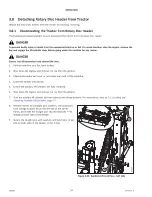
262391
48
Revision A
3.13.4
Cutterbar Angle
The cutterbar angle (sometimes called header angle) is the angle at which the cutterbar approaches the crop relative to the
ground. It is one of the variables that impact the cutting height and quality.
1024993
A
Figure 3.38: Cutterbar Angle
Cutterbar angle (A) adjustment ranges from 0° to 7° below the
horizontal plane. Choose an angle that maximizes the
performance for your crop and field conditions. A flatter angle
provides better clearance in stony conditions, whereas a steeper
angle is required in lodged crops for better lifting action.
Check the float after significantly adjusting the cutterbar angle.
Adjusting the cutterbar angle affects the header float, because
the header
’
s center of gravity shifts when the cutterbar angle is
changed.
Adjusting Cutterbar Angle
–
Mechanical Center-Link
Cutterbar angle is one of the settings that affects cutting height. On machines equipped with mechanical center-links, you
can adjust the cutterbar angle manually.
To adjust the cutterbar angle on a machine with a mechanical center-link, follow these steps:
DANGER
To prevent injury or death from the unexpected start-up of the machine, always stop the engine and remove the key
from the ignition before leaving the operator
’
s seat for any reason.
DANGER
Ensure that all bystanders have cleared the area.
1.
Lower the header fully.
2.
Shut down the engine, and remove the key from the ignition.
ϭϬϰϯϲϵϯ
A
B
Figure 3.39: Mechanical Center-Link
3.
Loosen nut (A).
4.
Decrease (flatten) cutterbar angle by rotating turnbuckle
sleeve (B) to decrease the turnbuckle length.
5.
Increase (steepen) cutterbar angle by rotating turnbuckle
sleeve (B) to increase the turnbuckle length.
6.
Tighten nut (A) but do
NOT
overtighten. A slight tap with a
small hammer is sufficient.
7.
Check cutting height and adjust if required.
8.
Check the float and adjust if required. For adjustment
instructions, refer to
















































